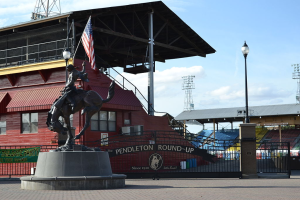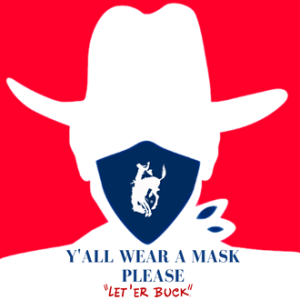1.1 Chapter Overview and Learning Objectives
1.1.1 Learning Objectives
- Explain concepts central to sociology, such as society, sociological perspective, structure, institutions, and agency.
- Describe and apply the sociological imagination.
- Relate how diversity informs one’s sociological perspective through the study of human differences that exist within systems of privilege and oppression.
- Employ macro and micro level analysis to understand the role of structure, agency, and institutions in society.
- Explain why it is worthwhile to study sociology.
- Identify ways sociology is applied in the real world.

“Let’er buck!”
If you’ve ever attended the Pendleton Round-Up in Pendleton, Oregon (figure 1.1), or participated in other rodeos, you’ve heard this catchphrase, first used in 1910 to kick off “a frontier exhibition of picturesque pastimes, Indian and military spectacles, cowboy racing and bronco busting” (Pendleton Round-Up n.d.). For many people living in the West, Oregonians in particular, rodeos are part of their history and hold a vital role in their communities.
You might wonder why a sociologist would be interested in studying rodeos, but rodeos like many other activities provide an opportunity to learn more about human behavior. Sociologists see events like Round-Up as a way to learn more about history, culture, interactions between groups, and interactions between people within social structures. To study the sport of rodeo, we look past some of the physical activity, and may focus on the patterns of participation and exclusion, as well as explore the connections between the event and to other social phenomena.
On the surface level, we see that the Pendleton Round-Up provides entertainment, displays athleticism, and builds community, but if we step back to examine the layers and levels of social interactions that occur there, we can uncover more about how and why groups of people behave as they do in particular situations. The Pendelton Round-up was founded in 1910 by the town’s professionals and businessmen with the aim of providing entertainment centered on the community’s roots in the Wild West (Willingham 2021). The Round-Up includes Native Americans by inviting the Confederated Tribes of the Umatilla Indian Reservation (CTUIR) and tribal members throughout the Northwest to participate in the event. This event that may appear to serve as entertainment that centers around the history and culture of the Wild West also serves additional functions. The week of Round-Up and the days leading up to it are important to the community’s economy. The Round-Up brings in tourism that supports local artisans, restaurants, and other businesses – for some, that week’s worth of commerce helps cover periods that are less lucrative.
How does rodeo inform sociologists about group compositions and interactions? In Oregon, black cowboys brought an element of diversity to rodeos, but historically unlike other frontier states, few black cowboys lived and worked in the state (Fonseca 2022). Why might this be, when historical documents suggest that in other spaces African Americans held vital roles in building non-Indigenous communities and participating in rodeos? Sociologists want to understand how policies in our social structure and inequalities experienced by groups contribute to demographic patterns.
It’s no secret that Oregon was known as a state with sundown towns— almost exclusively white towns with an unspoken rule that blacks were not safe to live or spend the night. In the 19th century, this residential segregation was reinforced with the use of police, fire, bricks, and unwelcoming signs (Loewen 2005). At the state level, black exclusion was written into the law. Only in 2002 did 70 percent of voters decide to remove the racist language from the state constitution (Camhi 2020). However, an examination of historical documents and life histories reveals the importance of Latinx vaqueros and black cowboys in shaping rodeo (Patton and Shedlock 2011). Further, even though there is little visual representation, the ways in which women, indigenous people, and small-town amateurs embraced rodeo as a sport influenced the organization of events (Mellis 2003).
Social issues such as a global pandemic affect many aspects of our lives, such as sporting events. With the global COVID-19 pandemic, the Pendleton Round-Up Rodeo was canceled for the first time since 1943 (Castillo 2021). This decision was one that impacted several social institutions, but let’s focus on the economy and healthcare. Financially this was a significant loss for small businesses, artisans, food vendors, and competitors who depend on the revenue generated by this annual event. However, Umatilla County was not the only place affected by a loss of revenue from tourism during the pandemic.
Health and safety concerns stemming from an overburdened healthcare system led to interventions to limit the transmission of the virus that causes COVID-19. For instance, government and public health officials implemented stay-at-home orders, curfews, and quarantines to reduce the spread of SARS-CoV-2. A medical sociologist might examine issues of social inequality by studying the ways that this virus leads to higher health disparities for Black, Indigenious, and People of Color (BIPOC) (Centers for Disease Control [CDC] 2022).
When we discuss healthcare at a structural level, we ask questions like who has access and what are barriers others may experience? How does access impact life chances, morbidity, and mortality for groups of people? In the case of the COVID-19 pandemic, these questions surrounded decision makers when it came to the planning of events that may expose populations to SARS-CoV-2.
The Pendleton Round-Up occurs in Umatilla County and includes participation from Confederated Tribes of the Umatilla Indian Reservation (CTUIR)1 and other tribal members in the region—community members that are disproportionately affected by COVID-19.
The following year, the Pendleton Round-Up was scheduled to occur with some health and social distancing precautions in place. Leading up to Round-Up in 2021, a second state of emergency was declared in Umatilla county due to COVID case counts, the rise of new variants, and limited hospital bed capacity—all which led to the mask mandate (Hagar 2021). Figure 1.2 shows the guidelines update from the Round-Up’s website asking people to wear face masks after mask wearing was mandated by the government in the state of Oregon.

During a global pandemic, decisions surrounding community gatherings impact several parts of our social structure. Despite signage requiring the use of masks, reports suggest that compliance may not have been high. This is particularly problematic in a county with one of the lowest vaccination rates in the state. The county saw a spike in COVID-19 case numbers following Round-up to the extent that CTUIR declared a state of emergency after the Pendleton Round-Up in 2021 as case counts on the reservation rose to 72 within a week (CTUIR ICT 2021).
According to a report given by the Public Health Director Joseph Fiumara on Oregon Public Broadcasting, hospitalizations and case counts rose following Round-Up (AP Staff 2021). While Oregon was experiencing less hospitalizations and cases prior to Round-Up, an event of this magnitude contributed an additional strain on the healthcare systems in Umatilla and Wallowa counties. In this chapter you will learn how to examine activities, such as Round-Up through a sociological lens and begin to understand how an everyday event impacts other social institutions.
At times it may seem as though sociologists (and your professor) are speaking in some sort of code: Structure? Agency? Social institutions? Our “secret language” reflects key concepts and ideas commonly used in the discipline of sociology. This chapter will help introduce you to these concepts and ignite your own sociological imagination, a concept we’ll discuss in the next section. Sociologists seek out opportunities to learn more about social life by using social scientific approaches to study everyday interactions and broader patterns in society. In this chapter, you will explore what sociology is and how the sociological perspective can be applied in everyday life.
1.1.2 Licenses and Attributions for Overview
“Overview” by Jennifer Puentes is licensed under CC BY 4.0.
Figure 1.1. Chapter opening image of Pendleton Round-Up Stadium gate and statue. Photo by Visitor7. Pendleton Round-Up. License: CC BY-SA 3.0
Figure 1.2. Image of a person in a cowboy hat wearing a mask with the “Let ’er Buck” logo from Pendleton Round-Up website. Used Under Fair Use.
1 The Confederated Tribes of the Umatilla Indian Reservation is made up of the Cayuse, Umatilla, and Walla Walla Tribes, formed under the Treaty of 1855 signed in the Walla Walla Valley.
